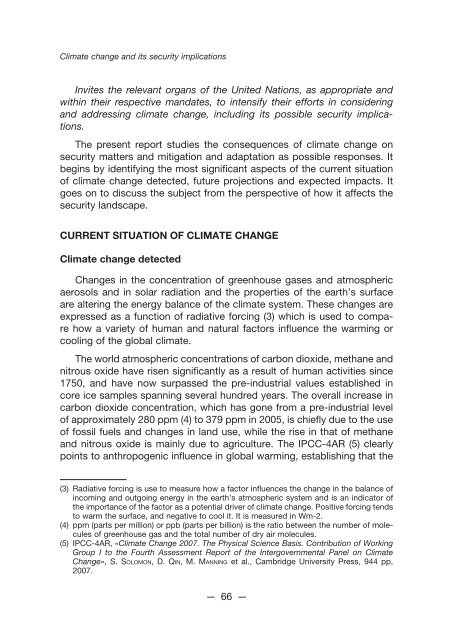Strategic Panorama 2009 - 2010 - IEEE
Strategic Panorama 2009 - 2010 - IEEE
Strategic Panorama 2009 - 2010 - IEEE
Create successful ePaper yourself
Turn your PDF publications into a flip-book with our unique Google optimized e-Paper software.
Climate change and its security implications<br />
Invites the relevant organs of the United Nations, as appropriate and<br />
within their respective mandates, to intensify their efforts in considering<br />
and addressing climate change, including its possible security implications.<br />
The present report studies the consequences of climate change on<br />
security matters and mitigation and adaptation as possible responses. It<br />
begins by identifying the most significant aspects of the current situation<br />
of climate change detected, future projections and expected impacts. It<br />
goes on to discuss the subject from the perspective of how it affects the<br />
security landscape.<br />
CURRENT SITUATION OF CLIMATE CHANGE<br />
Climate change detected<br />
Changes in the concentration of greenhouse gases and atmospheric<br />
aerosols and in solar radiation and the properties of the earth’s surface<br />
are altering the energy balance of the climate system. These changes are<br />
expressed as a function of radiative forcing (3) which is used to compare<br />
how a variety of human and natural factors influence the warming or<br />
cooling of the global climate.<br />
The world atmospheric concentrations of carbon dioxide, methane and<br />
nitrous oxide have risen significantly as a result of human activities since<br />
1750, and have now surpassed the pre-industrial values established in<br />
core ice samples spanning several hundred years. The overall increase in<br />
carbon dioxide concentration, which has gone from a pre-industrial level<br />
of approximately 280 ppm (4) to 379 ppm in 2005, is chiefly due to the use<br />
of fossil fuels and changes in land use, while the rise in that of methane<br />
and nitrous oxide is mainly due to agriculture. The IPCC-4AR (5) clearly<br />
points to anthropogenic influence in global warming, establishing that the<br />
(3) Radiative forcing is use to measure how a factor influences the change in the balance of<br />
incoming and outgoing energy in the earth’s atmospheric system and is an indicator of<br />
the importance of the factor as a potential driver of climate change. Positive forcing tends<br />
to warm the surface, and negative to cool it. It is measured in Wm-2.<br />
(4) ppm (parts per million) or ppb (parts per billion) is the ratio between the number of molecules<br />
of greenhouse gas and the total number of dry air molecules.<br />
(5) IPCC-4AR, «Climate Change 2007. The Physical Science Basis. Contribution of Working<br />
Group I to the Fourth Assessment Report of the Intergovernmental Panel on Climate<br />
Change», S. So l o m o n, D. Qin, M. Ma n n i n g et al., Cambridge University Press, 944 pp,<br />
2007.<br />
— 66 —

















